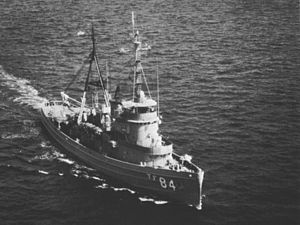Cherokee-class fleet tug

USS Cree (ATF-84) underway in 1970
|
|
| Class overview | |
|---|---|
| Operators: |
|
| Preceded by: | Bagaduce-class fleet tug |
| Built: | 1938-1943 |
| Completed: | 28 |
| Lost: | 3 |
| General characteristics | |
| Type: | Fleet tug |
| Displacement: | 1,235 long tons (1,255 t) |
| Length: | 205 ft (62 m) |
| Beam: | 38 ft 6 in (11.73 m) |
| Draft: | 18 ft (5.5 m) |
| Propulsion: | Diesel-electric, 1 shaft, 3,600 hp (2,685 kW) |
| Speed: | 16.5 knots (30.6 km/h; 19.0 mph) |
| Complement: | 85+ |
| Armament: |
|
The Cherokee class, originally known as the Navajo class, was a class of fleet tugs built for the United States Navy prior to the start of World War II. They represented a radical departure from previous ocean-going tug designs, and were far more capable of extended open ocean travel than their predecessors. This was due in large part to their 205 feet (62 m) length, 38 feet (12 m) beam, and substantial fuel-carrying capacity. They were also the first large surface vessels in the US Navy to be equipped with diesel/electric drive.
The first three vessels, Navajo, Seminole and Cherokee, were constructed from 1938-1940 at the Staten Island Shipyard division of Bethlehem Steel Corp. Navajo and Seminole joined the Pacific fleet in 1940, and Cherokee to the Atlantic fleet. Navajo was en route to San Diego from Pearl Harbor on December 7th, 1941, and immediately reversed course back to Pearl Harbor once news broke of the Japanese attack. She became a critical element of salvage operations there, as did her sister ship Seminole, in the days following the attack.
Following the loss during WW2 of the first two ships of the class, Navajo and Seminole, the class was renamed from its original pre-war name of Navajo-class to Cherokee-class, the name of the third ship laid in 1939 which still survived.
This article incorporates text from the public domain Dictionary of American Naval Fighting Ships.
...
Wikipedia
